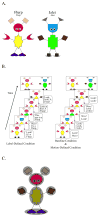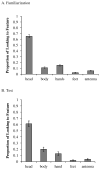Linguistic labels, dynamic visual features, and attention in infant category learning
- PMID: 25819100
- PMCID: PMC4394365
- DOI: 10.1016/j.jecp.2015.01.012
Linguistic labels, dynamic visual features, and attention in infant category learning
Abstract
How do words affect categorization? According to some accounts, even early in development words are category markers and are different from other features. According to other accounts, early in development words are part of the input and are akin to other features. The current study addressed this issue by examining the role of words and dynamic visual features in category learning in 8- to 12-month-old infants. Infants were familiarized with exemplars from one category in a label-defined or motion-defined condition and then tested with prototypes from the studied category and from a novel contrast category. Eye-tracking results indicated that infants exhibited better category learning in the motion-defined condition than in the label-defined condition, and their attention was more distributed among different features when there was a dynamic visual feature compared with the label-defined condition. These results provide little evidence for the idea that linguistic labels are category markers that facilitate category learning.
Keywords: Attention; Category learning; Cognitive development; Dynamic visual cues; Eye-tracking; Infancy; Labeling.
Copyright © 2015 Elsevier Inc. All rights reserved.
Figures









Similar articles
-
Effects of Linguistic Labels on Visual Attention in Children and Young Adults.Front Psychol. 2018 Mar 21;9:358. doi: 10.3389/fpsyg.2018.00358. eCollection 2018. Front Psychol. 2018. PMID: 29618996 Free PMC article.
-
The role of labels and motions in infant category learning.J Exp Child Psychol. 2021 May;205:105062. doi: 10.1016/j.jecp.2020.105062. Epub 2021 Jan 25. J Exp Child Psychol. 2021. PMID: 33508654
-
Labels direct infants' attention to commonalities during novel category learning.PLoS One. 2014 Jul 11;9(7):e99670. doi: 10.1371/journal.pone.0099670. eCollection 2014. PLoS One. 2014. PMID: 25014254 Free PMC article.
-
Infant categorization: memory for category-level and specific item information.J Exp Child Psychol. 1990 Aug;50(1):131-55. doi: 10.1016/0022-0965(90)90036-8. J Exp Child Psychol. 1990. PMID: 2398330
-
The development of category specificity in infancy--What can we learn from electrophysiology?Neuropsychologia. 2016 Mar;83:114-122. doi: 10.1016/j.neuropsychologia.2015.08.021. Epub 2015 Aug 21. Neuropsychologia. 2016. PMID: 26305018 Review.
Cited by
-
The benefits of immature cognitive control: How distributed attention guards against learning traps.J Exp Child Psychol. 2023 Feb;226:105548. doi: 10.1016/j.jecp.2022.105548. Epub 2022 Sep 17. J Exp Child Psychol. 2023. PMID: 36126587 Free PMC article.
-
Selective attention, diffused attention, and the development of categorization.Cogn Psychol. 2016 Dec;91:24-62. doi: 10.1016/j.cogpsych.2016.09.002. Epub 2016 Oct 7. Cogn Psychol. 2016. PMID: 27721103 Free PMC article.
-
The nature of label-induced categories: preverbal infants represent surface features and category symbols.Proc Biol Sci. 2024 Nov;291(2035):20241433. doi: 10.1098/rspb.2024.1433. Epub 2024 Nov 20. Proc Biol Sci. 2024. PMID: 39561796 Free PMC article.
-
Effects of Linguistic Labels on Visual Attention in Children and Young Adults.Front Psychol. 2018 Mar 21;9:358. doi: 10.3389/fpsyg.2018.00358. eCollection 2018. Front Psychol. 2018. PMID: 29618996 Free PMC article.
-
"The eyes are the window to the representation": Linking gaze to memory precision and decision weights in object discrimination tasks.Psychol Rev. 2024 Jul;131(4):1045-1067. doi: 10.1037/rev0000475. Epub 2024 May 16. Psychol Rev. 2024. PMID: 38753387 Free PMC article.
References
-
- Balaban MT, Waxman SR. Do words facilitate object categorization in 9-month-old infants? Journal of Experimental Child Psychology. 1997;64:3–26. - PubMed
-
- Blair M, Watson MR, Meier KM. Errors, efficiency, and the interplay between attention and category learning. Cognition. 2009;112:330–336. - PubMed
-
- Booth AE, Waxman SR. Object names and object functions serve as cues to categories for infants. Developmental Psychology. 2002;38:948–957. - PubMed
Publication types
MeSH terms
Grants and funding
LinkOut - more resources
Full Text Sources
Other Literature Sources
Medical

